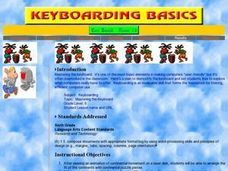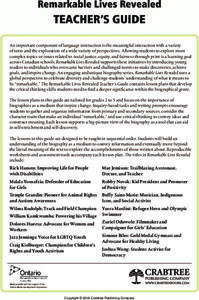Curated OER
Mastering the Keyboard
Sixth graders view an animated program showing how the continents fit together millions of years ago. In groups, they compare and contrast the distribution of rocks and fossils based on how the continents fit together. After reading a...
Curated OER
Animals Around Us
Young scholars view and discuss a Discovery Channel video that compares the animals found in four different habitats. They compare and contrast the characteristics of forests, deserts, wetlands and grasslands then choose one to depict...
Curated OER
Natural Born Robots: Body Builders
Students perform activities to explore how their arm works and what muscles are involved. They view animated comparisons of human and robotic arms. Students create a model of the human arm.
Curated OER
Digital Mitosis and Claymation
Take mitosis and meiosis out of the biology textbook and onto the screen! An innovative class project prompts young biologists to create an animation movie using clay, showing the phases involved in mitosis or meiosis by...
Curated OER
So You Think You're Tough
Fourth graders learn how to classify animals. In this invertebrates lesson plan, 4th graders discuss how we classify thinks into groups and move into a discussion about classifying animals. Students learn about the differences between...
Curated OER
The Scientific Method
Students connect the scientific method to real world situations. In this scientific method lesson, students discuss the work of Dr. Renshaw in making a diagnosis and connected to the scientific method. Students view a website video...
Curated OER
What's For Dinner?
Students share their own views on eating genetically altered foods. After reading an article, they research any issues concerning these types of foods in the United States. In groups, they create a campaign slogan to help gain funding...
Curated OER
Introductions to Biotechnology
Although this PowerPoint has valid information, the 49 slides may not engage your students as much as necessary. Each slide has a title and 2 or 3 bullet points, but no images or external resource links to break up the...
Crabtree Publishing
Remarkable Lives Revealed
Six lessons make up a unit all about biographies. Scholars read about a remarkable life while taking notes and identifying characteristics of the biographical genre. Readers examine the tale's obstacles, accomplishments, and sequence of...
Curated OER
Where the Red Fern Grows: A 4th Grade Literary Focus Unit
Fourth graders explore the human and animal connection along with the idea that death is a part of the life cycle. They read "Where the Red Fern Grows." Students examine the feelings and emotions surrounding death and they discover the...
Curated OER
Looking into Careers: Doing What I Like and Liking What I Do
Students explore careers. For this service learning lesson, students consider the value of job satisfaction and explore non-traditional jobs related to animal welfare.
Curated OER
Teaching African Literature in English
Young scholars do a research project on one of the European countries and develop the points in detail. They determine the sophistication of African tradition and culture that have been degraded by the media and write an essay from the...
Curated OER
Acting Like a Bunch of Animals: Fables and Human
The video "The Tales of Aesop" traces for viewers the history of fables and identifies their characteristics. The class then goes to the web site "The Fisherman and the Little Fish" where they examine the classic and a modern version of...
Curated OER
Frankenstein - Frankenfolio
Students engage in a variety of activities in order to appreciate the literature of Frankenstein. They create a portfolio that tracks progress towards mastering skills and stated objectives.
Curated OER
Unleashed: Poems by Pets
Students create a poem from the first person perspective of a pet. In this Writing/Poetry lesson, students read a short poem from, Unleashed. Students brainstorm what their animal may say. Students write a poem using the first...
Alabama Learning Exchange (ALEX)
Whales, Whales, Whales!
The title says it all! Help your pupils learn all about whales. Class members research different species of whales and share the information via video conferences with kids from another school. They conduct research on a selected species...
Curated OER
Optimal Foraging
Students participate in a foraging activity that demonstrates environmental conditions playing an important role in determining the optimal foraging behavior of a particular organism.
Curated OER
Animals
Pupils identify the names of animals in Spanish. Using plastic models, they point, touch and view the animal. They practice counting and stating the color of the animal as well. They make the sounds their favorite animal makes.
Curated OER
Calavaras Puppets
Fifth graders view skeleton images used in the Dia de los Muertos festival and hear the Mexican tale "Sister Death and the Healer." They identify the view of death held by the Mexican people.
Curated OER
Farm Products Help Me Grow
Students view a display of empty food containers (or illustrations). They select a food and decide as a class if it has an animal or plant origin. Students view a display of common farm animals that are commonly eaten (cow, pig, chicken,...
Curated OER
Cells & Their Function
Students review cell theory, identify major organelles found in typical cell, describe function of each major organelle, compare plant and animal cells, and demostrate understanding that cancer is caused by uncontrolled division of cells.
Curated OER
Persuading the Assembly
Students critique a power point presentation. They create power point presentation.
Curated OER
Masking: Honoring Animals, Ancestors, and Gods
Students analyze the role of masks in African culture. In this African masks lesson, students read about the importance and meaning of imagery of African masks. Students observe animals in local ecosystems and create a mask combining the...
Curated OER
Dryline Characteristics
Students view animations of several atmospheric variables (e.g., temperature, rainfall) during a cold front passage and locate the dryline, determine its direction of movement, and list at least two weather conditions associated with the...

























